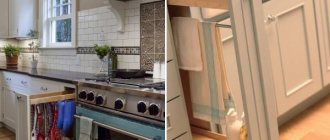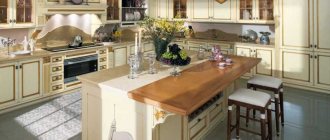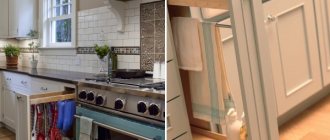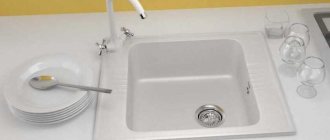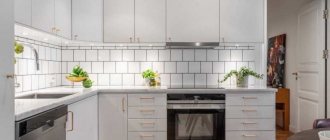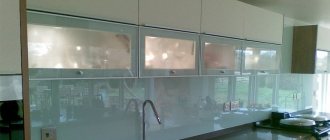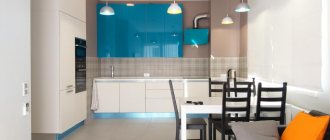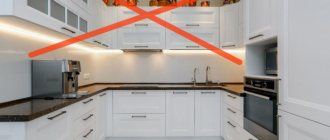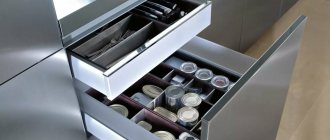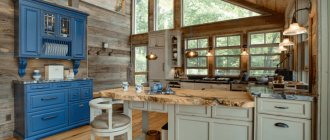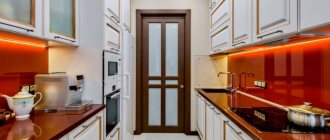What is it for?
Using the old furniture format, people noticed that getting the necessary item out of the kitchen cabinet, especially when this item is not used often, can be quite problematic.
To do this, you either need to dive headlong into the depths of the box, or you need to lay out everything that lies in front of the necessary thing, take out what you need and then put everything back. This is a tedious, long and inconvenient procedure.
To reduce or completely avoid these actions, a different approach to organizing kitchen furniture space was created. In order to make everything you need from the cabinets convenient and easy to take out, as well as compactly fit in drawers, we created pull-out systems for the kitchen.
Features and types of drawer guides
The highest rate of free access to things belongs to drawer systems. Forget about regular hinged doors with shelves, drawers are much more convenient. Not a single item, even a small one, will definitely be lost in them.
You can store pots, pans, cutlery and much more in them, thanks to internal divider flags or special trays on non-slip mats.
Today, there are several types of guides, on the basis of which drawer systems for the kitchen are made. The simplest ones are roller guides, they have a small load (on average up to 25 kg) and a short period of operation. The principle of operation is that the roller of one part moves along the groove of the other part. Very simple design.
The second type is ball bearing (ball, telescopic) guides, they come in standard and reinforced types. The latter are characterized by greater height and can withstand a significant load (on average more than 30 kg) without any problems. They can be presented in different opening/closing options: with or without a closer, from pressing on the facade (push-to-open).
The next type is hidden type guides. A distinctive feature is that when installing the box, the bar that provides movement is hidden under the bottom of the box.
Photos of retractable systems for the kitchen
Organization of space under the sink
There are several types of systems that will allow you to fill the cabinet under the sink not only with a trash can, but also with a large number of pull-out baskets for household chemicals and small items.
How to make it yourself
Making pull-out shelves in kitchen cabinets with your own hands is not at all difficult; the main thing is to make a choice and learn about the installation features.
Note! For the manufacture of the box itself, preference is given to MDF material, as it is resistant to moisture and deformation. Solid wood and chipboard are not recommended for these purposes.
- First of all, you need to calculate the dimensions of the future kitchen drawer.
- Decide on the type of retractable element.
- There should be a gap between the cabinet walls and the future shelf to accommodate fittings - as a rule, it is 13 mm.
- The depth of the shelf should be almost the full length of the retractable runner, minus 5-10 mm for the movement of the element, or minus 2 cm for the stiffeners, if any. The standard length of runners produced for kitchen cabinets is 25, 30, 35, 40, 45, 50, 55, 60 centimeters.
- The box must be exactly symmetrical, its diagonals must be the same.
- When using a tandembox or modernbox, the box already has sides; you only need to make the back and front strips and the bottom.
- Fix the false panels from the inside and install furniture handles.
Where can drawers be placed?
Please note: Modules with pull-out elements must be located in the kitchen so that they do not interfere with each other when opening. This is especially true for corner cabinets.
- While cooking, everything should be at hand, so retractable containers are needed, first of all, in the area of the working surface of the set. As a rule, small accessories are stored here, so roller or conventional telescopic mechanisms can be used.
- The corner cabinet is inconveniently deep and often remains unused or filled with unnecessary utensils. Today there is a solution for corner cabinets - retractable carousel-type mechanisms, a rack with tiered shelves on which you can place everything you need, and it will always be in sight.
- On the sides of cabinets - usually between two adjacent ones, or between a cabinet and a refrigerator/wall - you can make bottle holders. These narrow and long shelves are convenient for storing bottles of oil, sauces, jars of spices and some kitchen utensils that do not fit in the length of the cabinet.
Installation nuances
- The parts of the box are secured to each other with confirmations.
- The bottom of the shelf should be made of fiberboard or plywood (used less frequently), have high strength and rigidity, support the entire structure, and not sag.
- To attach the guides to the walls of the cabinets, you must first mark their correct location by measuring an equal distance from the bottom of the cabinet and drawing exactly horizontal lines on the inside wall on one side and the other.
- The cabinet guides are secured along these lines with self-tapping screws (roller) or screws with a cylindrical head of 3 mm
(telescopic), drawer slides of the guides - on the drawers, symmetrically to their body parts, with a 3 mm indentation from the front strip.
Filling
Pull-out shelves will be more convenient if they are supplemented with various partitions, cabinet organizers, baskets, etc. All these parts must be different in size and suitable for the kitchen utensils and accessories that are supposed to be stored in them.
Thanks to the internal organization of the shelves, they will increase their functionality, each item will be in sight and at hand, in its place, and there will always be order in the closets.
Boxes must be divided by partitions suitable for the size of a particular utensil.
